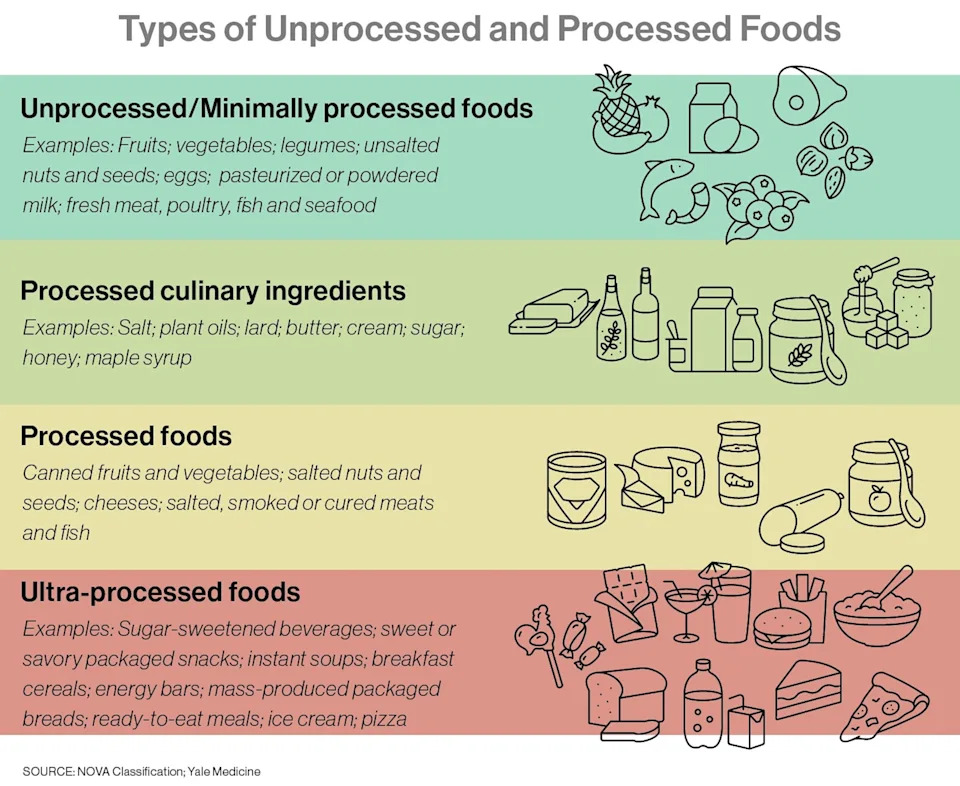The term "ultra-processed foods" has become common when discussing how healthy -- or unhealthy -- American diets are.
A report from the Centers for Disease Control and Prevention published early Thursday found that U.S. children and adults are getting more than 50% of their total calories from ultra-processed foods.
Health and Human Services Secretary Robert F. Kennedy Jr. has warned about the dangers of ultra-processed foods, saying they are one of the reasons behind the rise of chronic diseases in the U.S.

MORE: How eating ultra-processed foods could lead to increased risk of death, study shows
But knowing what an ultra-processed food is and how to identify it can be difficult.
ABC News spoke to public health experts about what constitutes as an ultra-processed food and the negative effects they can have on human health.
What are ultra-processed foods?
There is no standard definition in the U.S. of what ultra-processed foods are so most nutritionists, dietitians and food policy experts rely on the NOVA classification system developed by researchers at the University of São Paolo in Brazil in 2009.
The NOVA system divides foods into four groups, with group one being unprocessed or minimally processed such as fruits and vegetables; group two being processed culinary ingredients such as salt, sugar and oil; and group three being processed foods such as canned fruits and vegetables or salted meats.
Group four, or ultra-processed foods, are foods that are significantly altered from their original state through industrial formulations.

They can be made in a laboratory using substances extracted or derived from foods, additives, flavor enhancers or colorings. They generally contain little to no whole foods.
Examples include sugar-sweetened beverages, sweet or savory packaged snacks, instant soups, breakfast cereals, energy bars, mass-produced packaged breads, ready-to-eat meals, ice cream and pizza.
"These foods typically contain little of the original foods," Dr. Brian Wojeck, an assistant professor of medicine at Yale School of Medicine, told ABC News. "So, the difference between apple ice cream and an apple -- there's very little apple in apple ice cream. A lot of it is other ingredients."
How to identify ultra-processed foods
Experts say the best way to identify ultra-processed foods in the supermarket or grocery store is to read the ingredients list and nutritional facts panel.
If the ingredients are not items that would be found in the kitchen, it is likely an ultra-processed food.
MORE: Departing FDA chief weighs in on food dyes, safety of nation's food supply
"Sometimes the longer the list is, or the harder for you to understand those ingredients, it's going to be maybe a little tip-off that these are going to be an ultra-processed food," Jennifer Taylor, a registered dietitian nutritionist and Rutgers Family and Community Health sciences educator, told ABC News.
She went on, "Then looking at your nutrition facts panel is your other important thing. What you really want to look at is your added sugars, your fat content and calories."
Michele Polacsek, a professor of public health and director of the Center for Excellence in Public Health at the University of New England, said the one problem with reading food labels is they don't list the industrial processes that led to the creation of the ultra-processed item.
"It tells you what's in it, but it doesn't really tell you how it was made," she told ABC News. "So, if there was some way to tell that, you might be able to have more information, but that's not something that is shared with the public at the moment."
Are ultra-processed foods unhealthy?
Studies have shown that consumption of ultra-processed foods has been linked to weight gain. However, research has also found an association between ultra-processed foods and a higher risk of disease, such as cardiovascular disease, and even death.
A 2024 study led by researchers at Harvard T.H. Chan School of Public Health found that a high intake of ultra-processed foods may increase risk of early death. Participants who ate the most ultra-processed food of any kind had a 4% higher risk of death from any cause and an 8% higher risk of death from neurodegenerative diseases.

Another 2024 study from researchers in the U.S., France, Ireland and Australia found a direct association between greater ultra-processed food exposure and higher risk of deaths from cardiovascular disease.
To limit the amount of ultra-processed foods you are consuming, Taylor recommends making as many meals at home as possible and, on every trip to the grocery store, switching out one item that is typically bought for a less processed item.
"It can be very overwhelming, and that's why we want to make sure that people feel in control and able to make these small steps, because every little step is going to make a big difference in their health," she said.
Polacsek also recommends that policy makers create a standard definition for ultra-processed foods "so that manufacturers, supermarkets, schools, everybody can use that definition to decide, 'Do we sell this? Do we buy this? Do we not?'"




Comments